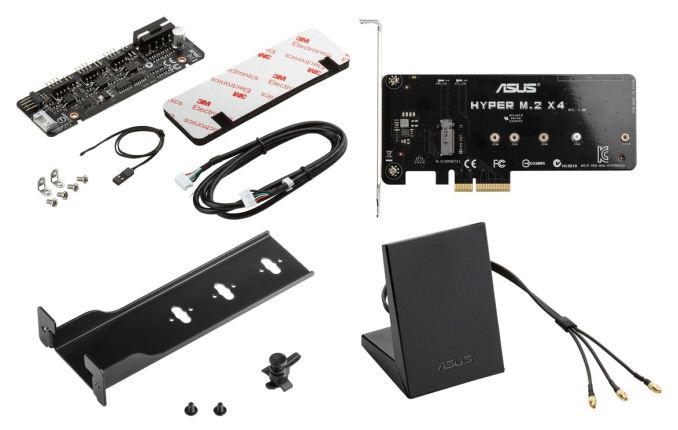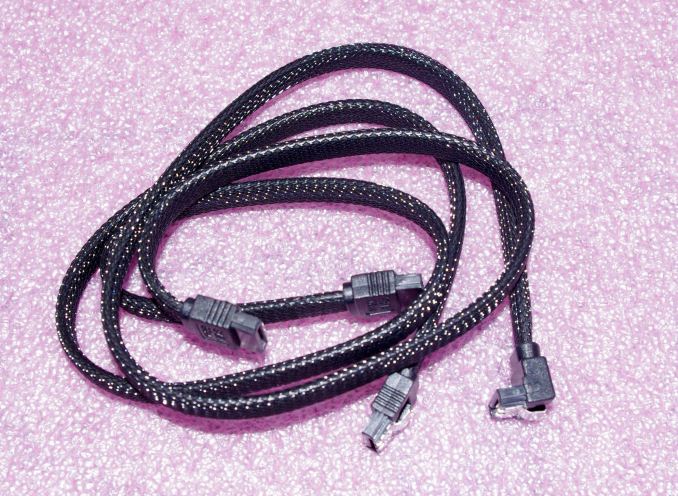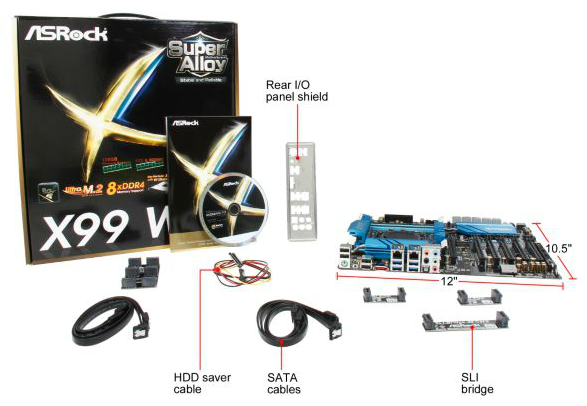The Intel Haswell-E X99 Motherboard Roundup with ASUS, GIGABYTE, ASRock and MSI
by Ian Cutress on September 25, 2014 11:30 AM ESTBox Contents and What to Expect
Over the years of reviewing motherboards, it is clear that the price of the overall package is a good indicator of what is inside the box. The cheaper motherboards below $100 rarely come with more than a couple of SATA cables, whereas the most expensive $500 comes with external goodies, like the Rampage IV Black Edition with the included OC Panel. Motherboard manufacturers often have a choice – strip the goodies out to make the product hit a lower price point, or invest in the end-user having an experience with the product as long as the extras make sense.
With X99, almost all the motherboards are in the high end category because X99 itself is a premium product, so we expect to see more than just SATA cables here. One of the common features with the gaming motherboards will be addition of licenses for gaming related software such as XSplit or even bundled games for certain regions.
ASUS X99-Deluxe In The Box
Due to the X99-Deluxe price point around $400, as well as the extra features like the vertical M.2 and Hyper x4 M.2, we get a fair amount of stuff:
Driver Disk
Manuals
Quick Installation Guide
Rear IO Shield
Vertical M.2 Brace and clips
Hyper M.2 x4 PCIe card
Wi-Fi Antenna for 3T3R
Fan Extension Card with adhesive
Two-pin Thermistor
3-Way SLI Flexible Connector
8 SATA Cables
In the past, ASUS has added extras into the box where they were not ultimately necessary – this time each addition is required to make something already on the motherboard to work. ASUS is still hedging its bets between SATA Express and M.2 however, with the vertical M.2 required to get extra functionality out of the limited PCB space.
GIGABYTE X99-UD7 WiFi In The Box
At around $310, the UD7 is just below the ASRock X99 WS in price but sits quite nicely in the middle of the X99 range between the super-high end and the low end of the spectrum. At certain points in the past GIGABYTE has given the user a reduced level of box extras in order to drive the price point of a motherboard down into another category, but that might not be so much of an issue here.
In the box we get:
Driver Disk
Manual
Rear IO Shield with LED Lighting
Flexi 2-way SLI Bridge
Short 3-way SLI Bridge
Long 3-way SLI Bridge
4-way SLI Bridge
Flexi 2-way Crossfire Bridge
WiFi Antenna
1 to 3 ATX 12V power cable
Six Sleeved SATA Cables
There is a healthy amount of SLI cables, including a long individual ones for three-way SLI with both 28 and 40 PCIe lanes CPUs. Adding the Crossfire bridge is a nice touch, as this seems to fly under everyone’s radar. Aside from the flashy IO shield and the antenna, one element stands out more than others: sleeved SATA cables!
This needs to be a thing in all motherboard boxes today. Even if it costs an extra $0.50 per motherboard for six cables (because manufacturers buy in bulk) I would certainly give this the thumbs up.
ASRock X99 WS In The Box
In our previous consumer oriented WS motherboard reviews, these types of motherboards are filled with SATA cables and SLI bridges to support multiple NVIDIA cards for compute. Workstation users might also require other connections from the COM or LPT adapters, depending on their use, although the ASRock X99 WS eschews those here in favor of its own HDD Saver cable.
In the box we get:
Driver Disk
Rear IO Panel
Manual
HDD Saver Cable for two SATA devices
Four SATA Cables
2-slot, 3-slot and 4-slot SLI bridges
ASRock is often generous with SATA cables, and previous levels of box contents have gone above and beyond the expected price point. At $324 this box bundle represents almost a bare minimum, and I would have expected a couple more SATA cables at least.
MSI X99S SLI Plus In The Box
Being the cheapest motherboard of the ones tested today, we would hazard a guess and say that it would be coming with the least kit included. $230 is in the middle to mid-high range for Z97 motherboards and might come with an extra free thing or two, but $230 is almost bottom of the pile for X99 and will most likely be treated as such. In the box we get the following:
Driver Disk
Manual
Rear IO Shield
Flexi SLI Bridge
Six SATA Cables
This is somewhat interesting. We have two more SATA cables than the ASRock motherboard, but it is odd that the X99S SLI Plus is designed around three-way GPU setups but we only get one SLI bridge in there. I would have assumed that users would be more interested in a three-way SLI Bridge than more SATA cables. However, because three-way SLI needs a strange way to connect them all, the extra cost of those cables might be prohibitive. Users will have to find SLI cables elsewhere for more than a 2-way graphics setup.















62 Comments
View All Comments
Ian Cutress - Friday, September 26, 2014 - link
Usually some of the 16xx series have some leeway, but the larger 26xx are definitely locked down. I've managed 107 MHz BCLK from an E5 2697 v3, but YMMV.halcyon - Thursday, September 25, 2014 - link
Is this correct:http://i.imgur.com/3AgxLfs.png
bebimbap - Thursday, September 25, 2014 - link
That's probably because the 5960x runs at 3.0-3.5ghz stock while the 4790k runs 4.0-4.4ghz stockso if it is single threaded MHz limited, then the 4790k can run 14%-47% faster than the 5960x can at stock settings.
Ian Cutress - Friday, September 26, 2014 - link
Minimum frame rate results are always tricky. If the system software initiates something critical in the foreground and causes a single frame to falter, then the whole minimum frame rate is reduced. That's why I'm not always too keen on reporting them, but have them included for completeness.The single thread speed is also another aspect, also depending on the cache orientation of the CPU, it might cause a frame or two to load faster/slower than others, again causing that one frame drop.
Given that this is more common across the Haswell-E line, compared to Haswell, it might be something that fundamental.
bebimbap - Thursday, September 25, 2014 - link
I had always thought MSI was a top tier vendor of MB and GPU's but after my gtx 8800 "malfunctioned," back when they were the best available, and then my z87 mpower MSI MB headers fall apart, and OC's at higher voltages compared to my z87 gigabyte ud5h and is hotter at the same voltages. It made me think about it, and MSI is very similar in marketing style as XFX. They are both usually heavy on rebates, and very cheap for the amount of product you get. But they lack quality. None of my XFX cards perform as well as their Asus/EVGA/Gigabyte counterparts. I now put them in the same tier as ECS and Biostar.The MSI board OC'd performance being less seemed more of the same, and I was expecting as much. Until something drastically changes, I'll only use Asus/Gigabyte/Asrock.
just4U - Thursday, September 25, 2014 - link
That's unfortunate.. however you do have to keep in mind that these are sensitive electronic components. I've had boards fail by all the major companies. It happens.. I had 3 dead boards in the Genie Rog Asus series all out of the first batch that came in (7 in total) did it stop me from using Asus? No.. again it happens. Had loose heatsinks dead chipset fans, a capacitor that fell off.. ugh.. Still if I dropped all the companies where that had happened I'd not have any companies to turn to lol.Msi is doing a lot of good things these days and their easily right up there with Gigabyte and Asus.
CFTheDragon - Thursday, September 25, 2014 - link
Why is there not the MSI X99 Gaming in the review? Is anyone really going to buy the normal version and not the Gaming one for a X99 build?Ian Cutress - Friday, September 26, 2014 - link
For review time, these are the samples we were sourced. Not every model is available for review, depending on how the manufacturer wants to focus on different titles. We asked MSI what their most popular/consumer focused board would be in terms of numbers, and they seem really pleased internally with the SLI Plus.The_Assimilator - Friday, September 26, 2014 - link
The only people who buy "Gaming" boards are the gullible who like bling and think that the KillerNIC is something desirable to have, rather than the liability it actually is.Flunk - Friday, September 26, 2014 - link
Unless the "Gaming" board happens to be cheaper, which happens a lot because I don't think they sell that great. Damn Killer NICs, just give me Intel and be done with it. Killer started off as nothing but marketing and since they've were bought out by Qualcomm they're just remarked Qualcomm parts with tweaked drivers. MSI's "Gaming" line is a really cynical take on the whole affair, it's just their regular boards with red highlights and (only on some models) a few small IC changes.